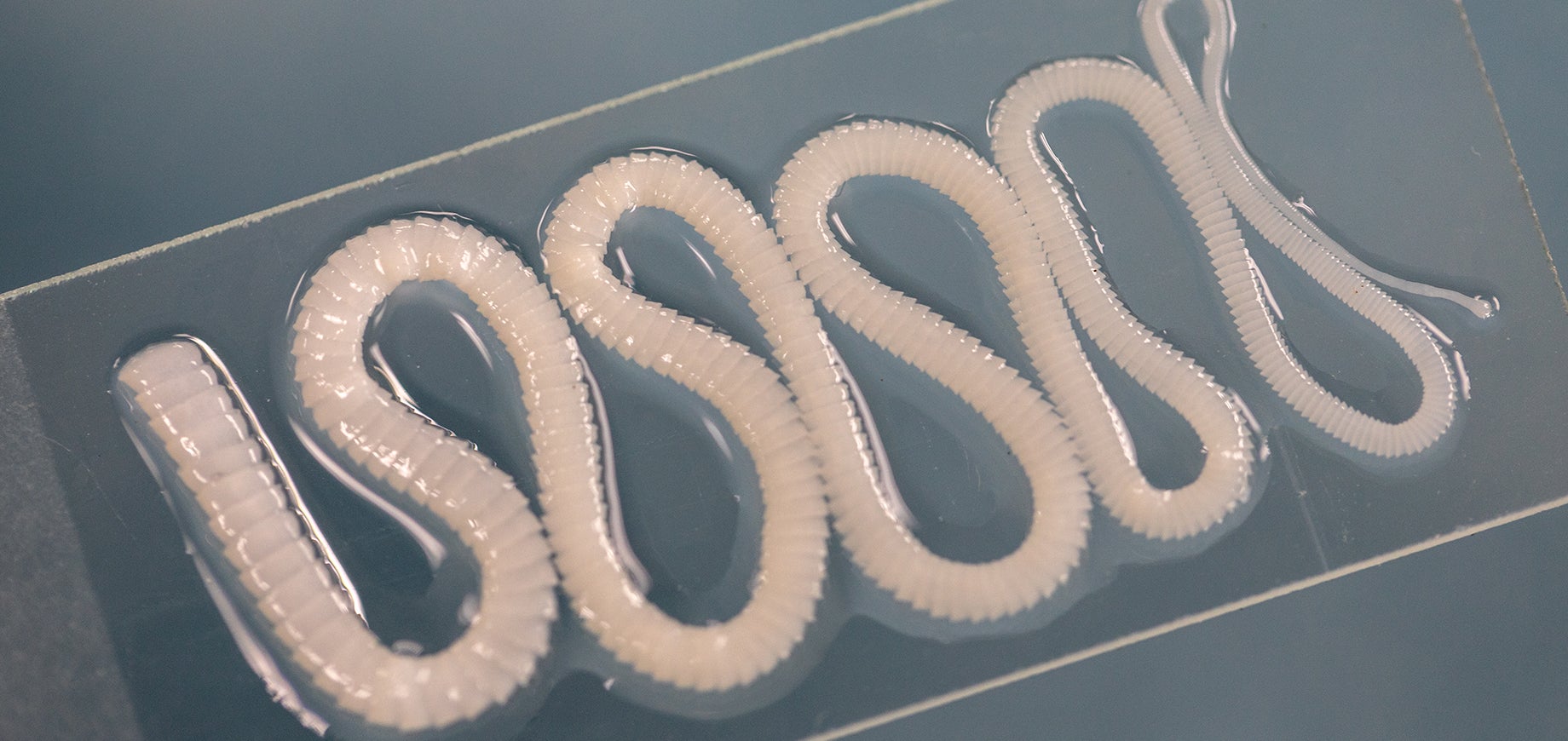Find products that match your dog’s needs

Tapeworms are flat, segmented parasites that reside in the intestines of dogs and cats. Unlike other common intestinal parasites like hookworms and roundworms, canine tapeworms belong to the cestode family. The most common tapeworms in dogs come from the species Dipylidium caninum. These parasites use hook-like mouthparts to anchor themselves to the small intestine's wall and can grow up to 11 inches long. As they mature, segments called proglottids break off and you may see tapeworms in dogs’ poop, resembling grains of rice. Understanding tapeworms in puppies and dogs is crucial to help you figure out the most effective tapeworm treatment for dogs.
Tapeworms in dogs primarily originate from their interactions with fleas, which can carry the larvae of these parasites. Here is the process of where canine tapeworms come from so you can better protect your furry friends.
The most common source of tapeworms in dogs is through the accidental ingestion of infected fleas. Fleas, carrying tapeworm larvae, can be ingested by dogs during grooming or scratching. Once inside, these larvae develop into adult tapeworms within the dog's small intestine. This process underscores the importance of effective flea control to prevent tapeworm infestations.
Tapeworms attach to the walls of a dog’s gut using their hook-like suckers. Once secured, they begin to absorb nutrients, grow, and produce segments called proglottids. These segments resemble grains of rice and are often seen as pieces of tapeworms in dogs poop or near the anus. While they commonly go unnoticed, severe infestations can lead to nutritional deficiencies and discomfort.
Both puppies and adult dogs can be affected by tapeworms, though puppies may not show clear signs of illness. Despite this, the potential for transmission to humans makes it essential to address tapeworm infestations diligently.
Identifying tapeworms in puppies can be tricky since symptoms are often subtle or absent. However, keeping up with a regular worming schedule can help prevent and control infestations. Common signs that may suggest a tapeworm issue include your puppy licking their bottom or scooting across the floor due to itchiness. Additionally, segments resembling rice or cucumber seeds might be visible signs of tapeworm in puppies’ poop or around their anus. In severe cases, your puppy may experience weight loss, diarrhea, or even vomit tapeworm segments. Observing these symptoms and maintaining a regular worming schedule will ensure your puppy stays happy and healthy.
Tapeworms are often elusive, with most dogs not displaying obvious symptoms. Yet understanding the telltale tapeworms in dogs symptoms can help you identify and address a tapeworm infestation early.
One of the primary indicators of tapeworms is the presence of small, rice-like segments in your dog's stool or around their rear. These segments, parts of the adult tapeworm, may be seen crawling on your dog’s bedding or fur.
As the segments dry out, they become yellow specks that can irritate your dog's skin, prompting behaviors like excessive licking or scooting. While scooting can also result from other issues, such as anal gland problems, it’s wise to consult your vet if you notice this behavior.
In rare cases, tapeworm segments may reach a dog’s stomach, leading to vomiting. You might see long worms in your dog's vomit if this occurs. If your dog frequently vomits, it could indicate a broader issue. You can learn more about the different types of dog vomit and what they mean here (interlinking for article).
Diagnosing tapeworms in dogs primarily relies on identifying specific physical signs. Often, pet owners first notice tapeworm segments, or proglottids, either in their dog's feces or vomit, prompting a visit to the veterinarian. These segments can appear as small, crawling objects on the surface of the feces or around the dog's anus. Unlike some other parasites, tapeworms are not easily detected through routine fecal examinations, as segments or eggs are not consistently present in every sample. To confirm a diagnosis, veterinarians will inspect the segments and may use a microscope to identify eggs in the stool. Occasionally, multiple stool samples are necessary to ensure accurate detection, especially when segments are not visible during each passing. If you observe any signs, contact your vet for proper diagnosis and treatment.
Effectively treating tapeworm infections in dogs is straightforward with modern veterinary medicine. It's essential to combine targeted deworming treatments with comprehensive flea control to prevent reinfestation.
Today's deworming medications offer a simple and highly effective solution to tapeworm infections. These medications, prescribed by veterinarians, can be administered either as tablets or through injections. The drugs work by dissolving the worms within the intestines, ensuring they are digested and not visible in your dog's stool. Not all deworming products are created equal, so it's important to rely on the advice of your veterinarian to select the most effective medication for your dog.
In addition to deworming, managing flea infestations is crucial to prevent reinfection. Since tapeworm larvae are often transmitted via fleas, controlling flea populations on your dog and in their environment is vital. Without diligent flea control, reinfection can occur within as little as two weeks. Your veterinarian can recommend the most effective and safe flea treatment options for your pet.
Preventing tapeworm infestations in your dogs is not only simple but also key to ensuring their long-term health. By taking a proactive approach, you can keep these pesky parasites at bay.
Fleas play a crucial role in transmitting tapeworms, so controlling their presence is vital. Consult your vet about the best flea treatment options available, such as sprays, collars, or topical solutions. Regular grooming and flea checks will further reduce the likelihood of infestation.
Work closely with your veterinarian to maintain a consistent deworming schedule tailored to your dog's needs. By sticking to a regular protocol, you can promptly address any potential worm issues before they escalate.
Preventing unsupervised roaming reduces exposure to environments where other animals or infected feces might be present. Always clean up after your pet in yards and parks to hinder the tapeworm lifecycle and keep your furry companion safe.
By integrating these simple steps into your pet care routine, you'll help your pup live a happy, tapeworm-free life.
Tapeworms in dogs can cause mild symptoms like scooting or licking due to irritation. While they are often not harmful, severe infestations may lead to weight loss and discomfort. Visible tapeworms in dogs' poop can indicate an infestation.
To prevent tapeworms in dogs, ensure effective flea control and maintain a regular deworming schedule with your vet. Avoid letting your dog roam unsupervised, especially in areas where infected animals or feces might be present.
Tapeworms in dogs do not go away on their own and require treatment. Effective tapeworm treatment for dogs involves prescription deworming medications and addressing flea infestations to prevent reinfection.
Tapeworms in puppies are generally not serious and usually don't cause illness. However, they can lead to symptoms like itching, scooting, or segments of tapeworm in puppies poop. It’s important to administer tapeworm treatment for puppies and maintain good flea control.

Find a PEDIGREE® stockist
near you!
Buy online
Click to buy from any of the retailers below

